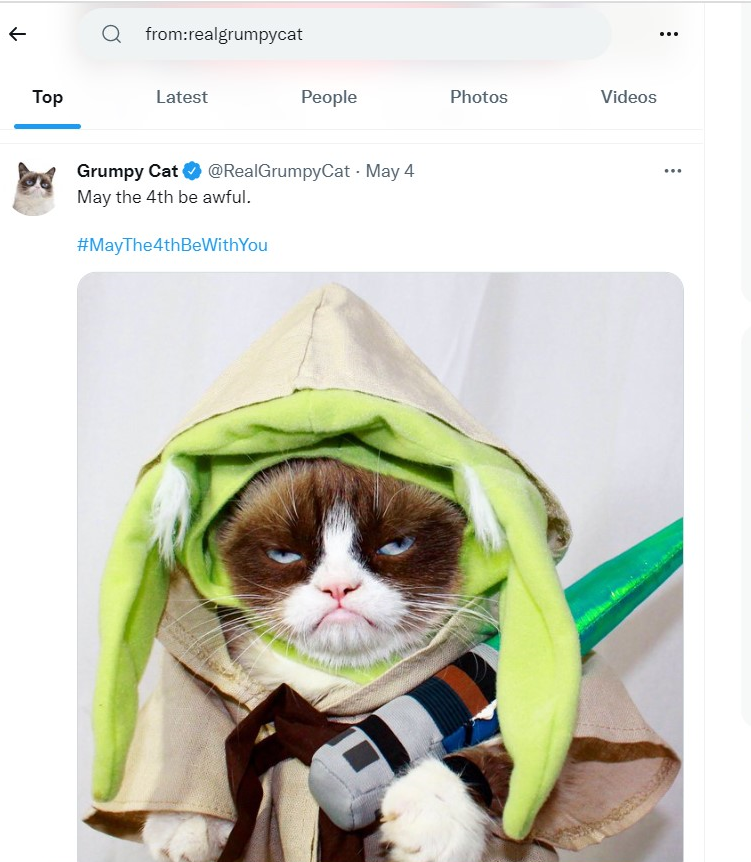Search and Stream
Overview
Teaching: 15 min
Exercises: 10 minQuestions
How can we specify what Tweets to collect?
How can we collect Tweets as they are posted?
Objectives
Search vs Stream
Twarc Search Command
Returns tweets posted during the past 7 days that match a given query. We can put in more than just one word, but for now let’s stick with a previous one-word search.
Earlier we searched for 500 posts for #catsofinstagram. Now let’s look for 2000.
Let’s make a new cell in our Notebook and run a search command. Remember that we need to
specify an output file. It is optional to use the > sign to signify the output file.
!twarc2 search --limit 2000 "(#catsofinstagram)" hashtag_cats.jsonl

This command will search for any recent tweets that contain #catsofinstagram. Twarc tells me that I hit my limit of 2000 after checking back in after a few minutes. If we had not limited our search and allowed twarc to gather 6-days’ worth of tweets, we would have used our entire download quota for the month.
We can use the visual indicator to confirm the limit of our second search. We may also open the file and see if we have something less than 2,000 tweets or 6 days worth. For this hashtag, you will probably hit your limit.
If you want to go back as far in time as the Twitter API allows (6 days
typically), and NOT eat up too much of your monthly quota, you can simultaneously
tighten up your search parameters and keep your --limit value low.
!twarc2 search --limit 500 "(#catsofinstagram #cute)" > hashtag_cats_500.jsonl
This adjusted search for tweets with BOTH of these hashtags, returns 5 out of six days. So asking for 800 Tweets should get me six days’ worth of results.
!twarc2 search --limit 800 "(#catsofinstagram #cute)" > hashtag_cats_800.jsonl
In this way we can ‘sip’ at our quota and make sure we can work within the 500,000 tweet limit.
Twitter Search
Twitter let’s us get much more specific (or broad, if we want) with our searches. twarc search command uses the same search syntax as the search bar on your Twitter home page

We will demonstrate some options you may use when searching tweets in both the Twitter search bar and through the Twarc search command. First, you may search tweets for content that contains certain words. In the example image below, we search for tweets about Grumpy Cat.
AND logic
In the Twitter search bar, using all-caps AND will return tweets containing
grumpy and cat.
Successive operators with a space between them will also result in boolean AND logic.
Words separated by a space will return tweets matching both conditions. In the
example below, this search will return tweets containing grumpy and cat
!twarc2 search "(grumpy cat)"
OR Logic
To search for tweets that contain either word, and not require both words, the search bar and Twarc will
use a capitalized OR instead. This will return results if either search condition is met.
In this case, the terms, grumpy or cat.
That same syntax holds for twarc2:
!twarc2 search "(grumpy OR cat)"
Not Logic
add a dash(-) to a keyword or operator to negate it (NOT). This works in both the twitter search bar and in twarc. This will match tweets containing the terms grumpy ORor cat, AND omit anything about Doja Cat.
!twarc2 search "(grumpy OR cat -Dojacat)"
Note that this searches for all tweets that contain the string cat
but NOT those containing DojaCat, PLUS all the tweets that contain
the word grumpy.
So you should get all the grumpy cats except for DojaCat.
Searching for Mentions of Users (@’ing)
The Twitter search and Twarc search command also supports looking for tweets that mention a specified twitter account (mentioning another Twitter account in a tweet is known as “at-ing/ @-ing” or “tagging”). In the below example, Jon @-ed the Twitter account @ucsblibrary.
Note that capitalization for the account name does not affect the search. Also, including the “@” symbol in front of the account name does not work, the search explicitly spells out the “to:” instead.
to: will match any tweet that is a reply to a partricular user. This can be the
username or the numeric user ID. You can only pass a single username/ID per to:
command.
!twarc2 search "(to:realgrumpycat)"
from: will match any tweet from a specific user. Like to:, this can be a username or numeric user ID.
!twarc2 search "(from:realgrumpycat)"

Using Hashtags
As we have seen before, we may also search tweets that contain hastags. In the example below, notice that the resulting tweet also contains other hashtags that we did not explicitly search for.

!twarc2 search "(#meme)"
Order of Operations
We have seen individual searches of each of these parameters. You may also combine these parameters to narrow down your results. When combining boolean functions the following order of operations will dictate how your query is evaluated.
- Operators connected by
ANDlogic are combined first - Operators connected by
ORlogic are combined after
For Example, internet cats Cole and Marmalade:

cats OR cole marmaladewould be evaluated ascats OR (cole marmalade)cats cole OR marmaladewould be evaluated as(cats cole) OR marmalade
To eliminate uncertainty, you can use parentheses to group terms together where appropriate. With Cole and Marmalade
(cats or cole) marmaladewhich would probably throw out cats, some guy named Cole, and orange preservativescats (cole marmalade)which would be closer to our internet cats
Grouping by using () to group terms and operators together in this way.
Challenge: Advanced Twarc Search
What resulting tweet(s) do you get from the following Twarc searches?
!twarc2 search "(grumpy cat #meme)" !twarc2 search "(grumpy cat) OR (#meme has:images)" !twarc2 search "(cats OR puppies) has:media" !twarc2 search "(to:_We_Rate_Cats) lang:en"Can you think of interesting search parameters for tweets? If so, use Twitter search or Twarc search to try them out.
Twarc Stream Command
You may also collect tweets as they are posted, and establish rules to what tweets will be collected (as you did for setting search parameters). To start with a stream, you set some tweet parameters or rules:
You may want to see ‘what’s trending’ on Twitter to make sure you get a good number of results here.
!twarc2 stream-rules add "#catsofinstagram"
🚀 Added rule for "#catsofinstagram"
!twarc2 stream-rules add "fluffy"
🚀 Added rule for "fluffy"
To see what your current stream rules are, you may list them:
!twarc2 stream-rules list
☑ #catsofinstagram
☑ fluffy
You may stream tweets that contain words and hashtags like we had done in Twarc search. We cannot use a username to stream tweets that mention another Twitter account:
!twarc2 stream-rules add "at:_We_Rate_Cats"
💣 UnprocessableEntity see: https://api.twitter.com/2/problems/invalid-rules
When you start collecting tweets with the rules you have set in place, you must create the file that the data will be stored in:
!twarc2 stream > "raw/streamed_tweets.jsonl"
Once this command is run, you will collect tweets that match the rules set in place.
This collection will be ongoing unless you explicitly shut down the stream by
interrupting the kernel (in Jupyter) or by typing a ctrl + c (from the console). While
this stops the stream collection, it does not remove the stream-rules.
Before running a new stream, don’t foreget to
remove the rules you had set in place. Use stream-rules delete:
!twarc2 stream-rules delete "#catsofinstagram"
!twarc2 stream-rules delete "fluffy"
Discuss: Search vs Stream
We had an introductory look at the use of the search command and the stream command. Please brainstorm what the difference(s) are between searching tweets and streaming tweets. When might you choose stream over search? How can you use them together?
Here is more information about using Twitter search syntax.
Our twitter guide gives advice about how to follow a real-time event, like pending #scotus decisions.
Key Points
Search: collect pre-existing tweets that satisfy parameters
Stream: collect Tweets that satisfy parameters, as they are posted